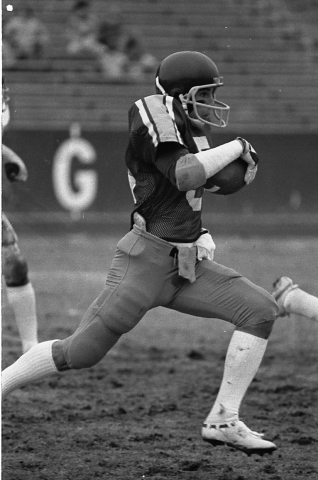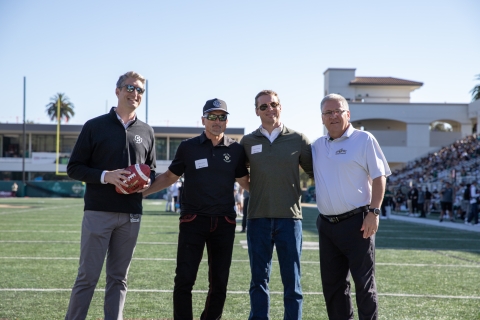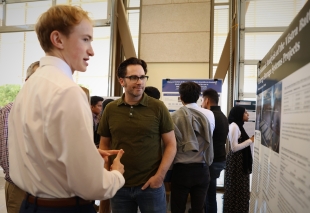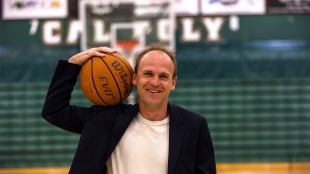The Big Score: Robbie Martin's Competitive Nature Helped Him Succeed Both in the NFL and Commercial Real Estate

An hour before his business calculus class was set to begin on the Cal Poly campus, Robbie Martin called his coach with the Indianapolis Colts to announce that his professional football career was over.
“I’m going to retire,” said Martin, who had finished an injury-riddled season just four months earlier. “The foot’s not healing, and it’s too much.”
On the other end, Ron Meyer, who had taken over as head coach during that 1986 season, listened as one of the league’s premiere punt returners called it quits.
“Who’s going to be my deep threat?” Meyer asked.
“It ain’t going to be me,” Martin answered.
Shortly after that long-distance call, Martin, then 27, was in a classroom, taking the final course he needed to finish his business degree. Surrounded by younger students as the instructor began writing theorems on a chalk board, Martin suddenly felt overwhelmed, even a little panicked, thinking about his talk with Meyer.
“I just got up and walked out of the class, and I didn’t come back,” he said.
While Martin would go on to have considerable success in the Silicon Valley commercial real estate industry, quitting school one course shy of a degree would needle him for decades.
“It always stuck with me,” he said. “I’m like, God -- I’m just one class away.”
Martin returned to Cal Poly Nov. 1, when he was recognized on Orfalea College of Business Day during the Mustang football team’s game against Portland State.

A Southern California native, Martin was a business administration major in 1980 when the Mustangs defeated no. 1-ranked Eastern Illinois for the Division II title. With NFL scouts in attendance and a national audience on ABC television, Martin was the star of that game, scoring three touchdowns – two receptions and one punt return. While that victory stands out in his football memories, it also paved the way for his pro career.
“That probably elevated me in the draft quite a bit,” he said. “To be on TV and then to have a good game . . . that probably did help a lot.”
Playing at a Division II school with a small frame (5-9, under 180 pounds) for an NFL player didn’t seem to bode well for his chances of playing professional football. But Martin wasn’t discouraged by what seemed like a longshot dream.
“Truthfully, it always was my goal, from Day One,” he said. “And we were fortunate that we had a lot of really good football players on that team. That helps a lot when you have good players working together to create good outcomes. And when you have good outcomes, you get attention.”
Even as he aspired to play professional football, Martin took his studies seriously.
“School was always a fallback position, but it was a very strong fallback position,” he said. “There are so many things that have to go right in the NFL.”
Martin finished his college football career with a long list of accolades – MVP of the program’s only championship game, receiving and punt return records, Athlete of the Year and more. But because of the rigors required for football, Martin was short of credits needed to graduate when his college football career ended. And when he was selected by the Pittsburgh Steelers in the 4th round of the NFL draft, he left California to pursue a dream.
“People who are good at sports who are competitive do fairly well at real estate. Because it’s competitive, and you have to want to win."
Robbie Martin
Despite his college success, he didn’t mesh with the Steelers head coach Chuck Noll, who led his teams to four Super Bowl titles.
“He’s a legend. Hall of Fame coach. But, you know, I didn’t have likeable feelings toward that guy,” Martin said.
Noll wanted Martin to become a running back, he said, but it wasn’t a good fit.
“Camp was rough, and he made it rough for me,” Martin said.
Eventually, the Steelers released him at the end of the preseason, and the Detroit Lions picked up his contract. Signed on as a receiver and special teams player, he thrived as a punt return specialist – a sometimes-scary job in the NFL.
“You’re on your own 10-yard line, and the ball's kicked sky high, and there are guys barreling down on you,” he said. “You know that there's trouble potential.”

In 1981 and 1982, Martin became a top-five punt returner in the league. And, before a national audience on Thanksgiving Day in 1983, he extracted a little revenge on the Steelers when he returned a kick for an 81-yard touchdown – the longest punt return in the NFL that year.
“As an ex-Steeler, it must have felt especially good for him to make that romp of 81 yards,” legendary broadcaster Dick Enberg said on NBC during the game.
As he ran past the Steelers’ sideline, en route to the end zone, Martin did think about Noll.
“I didn’t look to see him, but I knew I was running by him, and after I scored, I went toward the middle of the field and spiked the ball toward him,” he said. “My teammates knew that touchdown meant something to me.”
Even while playing in the NFL, Martin would return to San Luis Obispo during the off-season to take classes toward his degree. In one real estate class, an instructor had students read “The Art of the Deal,” the memoir and business book that helped solidify future President Donald Trump’s persona as a successful New York real estate mogul. The New Tork Times best-seller described high-stakes real estate endeavors, including hotels and skyscrapers.
“That’s why I got into commercial real estate,” Martin said. “That was probably my second year in the NFL. So then I started thinking, ‘This is where I’m going to go when this is over.’”
In the NFL, Martin returned three punt returns for touchdowns and went to the playoffs with the division-winning Lions in 1983.
The day he retired from the NFL, Martin said, going to class was simply too much.
“I had to sort things out,” he said. “Because that was the end of a big phase of my life.”
A year later, he accepted a commercial real estate job in San Jose.
“People who are good at sports who are competitive do fairly well at real estate,” he said, citing other former NFL players who transitioned to real estate careers. “Because it’s competitive, and you have to want to win.”
His second year in real estate, Martin said, he was out-earning his best year in the NFL.
“The valley is dynamic,” he said. “There’s always something coming up, and there’s a scarcity of land.”
His RLM Properties focuses on development, investment sales and leasing in the Silicon Valley market.
As his real estate career thrived, Martin continued to visit Cal Poly, attending football games at the Spanos Stadium. He has also supported the program, including the new John Madden Football Center, which is currently under construction at the stadium.
“Having good facilities helps players perform better and grow as an athlete,” said Martin, who was inducted in the Cal Poly Athletics Hall of Fame in 2005.
As he remained connected with Cal Poly through the years, Martin still regretted not earning that degree despite being so close. It was something he mentioned to the Athletics program during a visit 30 years after the championship.
“I just said, ‘Hey, you know what? I got this issue I really want to correct. If I could just find a way to finish this course, I’d like to get my degree.’”
Eventually, the school worked with Martin to earn his degree, allowing him to take a community college calculus course to earn his final credits.
Although Cal Poly has changed since he was a student, Martin said his alma mater has retained the charm he appreciated while attending classes and playing football as a Mustang.
“Cal Poly . . . I mean, what a great school,” he said. “There’s a little bit of wholesomeness about Cal Poly, and you don’t see that in too many places.”
Top photo: Robbie Martin returns a kick during his tenure with the Detroit Lions. (Photo: Detroit Lions)
The Orfalea College of Business has created impact hubs, such as the Real Estate Initiative, that aim to prepare students for successful careers and have a positive impact on communities.




